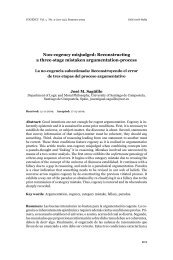Cogency v2 n2
Cogency v2 n2
Cogency v2 n2
You also want an ePaper? Increase the reach of your titles
YUMPU automatically turns print PDFs into web optimized ePapers that Google loves.
COGENCY Vol. 2, N0. 2, Spring 2010<br />
Slob thus contrasts his account to the dialectical account of Freeman<br />
(1991) and argues that his dialogical rhetoric produces a picture that is not<br />
possible on a dialectical understanding of argumentation. I think Slob reasonably<br />
emphasizes the importance of rebuttals: our understanding of the<br />
process of argumentation, and the accrued justification/rational acceptability,<br />
is enhanced, if we properly appreciate the role rebuttals play. But from a<br />
normative point of view, the complexities of the process of argumentation<br />
should project on some end-product, the argument, which we seek to evaluate.<br />
Slob, however, contends that<br />
dialectical approach is primarily focused upon the product of argumentation:<br />
only a clear-cut and orderly argument can be judged properly.<br />
Dialogical rhetoric, by contrast, follows the argumentative process and<br />
sees arguments as interchanges of supporting and rebutting forces. In<br />
my proposal, argument analysis does not serve evaluation, but serves<br />
the mapping of established reasons. Evaluation is no longer at stake in<br />
argument analysis, because a reason is only established when both discussants<br />
have in fact accepted it and thus have evaluated it positively.<br />
The map of established reasons forms a vector that leads up to the conclusion.<br />
Data form the basic ingredient, warrant forms the positive force<br />
of the argument and the rebuttal the negative counterpart. Argument<br />
analysis shows these two forces and display their relative contribution to<br />
the conclusion. (p. 180)<br />
The importance of understanding the force of rebuttals is exactly the<br />
impact they make on the eventual evaluation. The results may not always be<br />
clear-cut and orderly, but at least they are there to improve our understanding<br />
of a complex situation. Yet, Slob explicitly denies the connection between<br />
analysis and evaluation. Still, the analysis is supposed to show how<br />
these forces are relevant to the conclusion. This is all the more difficult to<br />
understand as Slob, later on the same page, writes:<br />
What is important is to map the established reasons and both participants<br />
are committed to these. In this way, a suitable conclusion is reached<br />
that both participants not only should, but will, accept. (Ibid.)<br />
166








